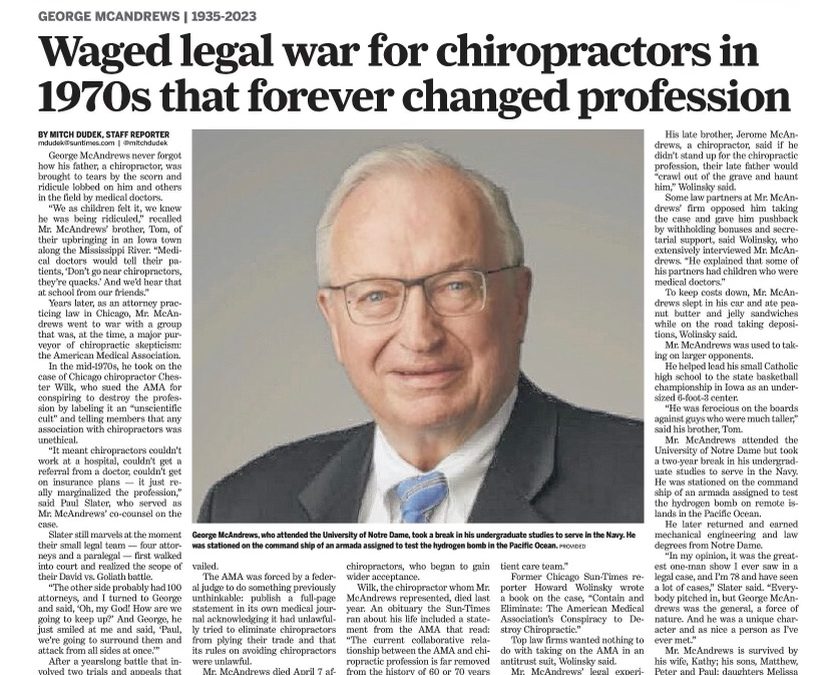“It was the greatest one-man show I ever saw in a legal case, and I’m 78 and have seen a lot of cases,” said attorney Paul Slater, a co-counsel on the case.
George McAndrews never forgot how his father, a chiropractor, was brought to tears by the scorn and ridicule lobbed on him and others in the field by medical doctors.
“We as children felt it, we knew he was being ridiculed,” recalled Mr. McAndrews’ brother, Tom, of their upbringing in an Iowa town along the Mississippi River. “Medical doctors would tell their patients, ‘Don’t go near chiropractors, they’re quacks.’ And we’d hear that at school from our friends.”
Years later, as an attorney practicing law in Chicago, Mr. McAndrews went to war with a group that was, at the time, a major purveyor of chiropractic skepticism: the American Medical Association.
In the mid-1970s, he took on the case of Chicago chiropractor Chester Wilk, who sued the AMA for conspiring to destroy the profession by labeling it an “unscientific cult” and telling members that any association with chiropractors was unethical.
“It meant chiropractors couldn’t work at a hospital, couldn’t get a referral from a doctor, couldn’t get on insurance plans — it just really marginalized the profession,” said Paul Slater, who served as Mr. McAndrews’ co-counsel on the case.
Slater still marvels at the moment their small legal team — four attorneys and a paralegal — first walked into court and realized the scope of their David vs. Goliath battle.
“The other side probably had 100 attorneys, and I turned to George and said, ‘Oh, my God! How are we going to keep up?’ And George, he just smiled at me and said, ‘Paul, we’re going to surround them and attack from all sides at once.’”
After a years-long battle that involved two trials and appeals that reached the U.S. Supreme Court — which declined to take on the case three times — Mr. McAndrews prevailed.
The AMA was forced by a federal judge to do something previously unthinkable: publish a full-page statement in its own medical journal acknowledging it had unlawfully tried to eliminate chiropractors from plying their trade and that its rules on avoiding chiropractors were unlawful.
Mr. McAndrews died April 7 after months of living with Alzheimer’s disease. He was 87.
The case was a turning point for chiropractors, who began to gain wider acceptance.
Wilk, the chiropractor whom Mr. McAndrews represented, died last year. An obituary the Sun-Times ran about his life included a statement from the AMA that read: “The current collaborative relationship between the AMA and chiropractic profession is far removed from the history of 60 or 70 years ago and has long reflected that physicians and chiropractors work side-by-side as members of the patient care team.”
Former Chicago Sun-Times reporter Howard Wolinsky wrote a book on the case, “Contain and Eliminate: The American Medical Association’s Conspiracy to Destroy Chiropractic.”
Top law firms wanted nothing to do with taking on the AMA in an antitrust suit, Wolinksy said.
Mr. McAndrews’ legal experience was mostly as a patent attorney. But he was motivated to take on the legal challenge.
His late brother, Jerome McAndrews, a chiropractor, said if he didn’t stand up for the chiropractic profession, their late father would “crawl out of the grave and haunt him,” Wolinsky said.
Some law partners at Mr. McAndrews’ firm opposed him taking the case and gave him pushback by withholding bonuses and secretarial support, said Wolinsky, who extensively interviewed Mr. McAndrews. “He explained that some of his partners had children who were medical doctors.”
To keep costs down, Mr. McAndrews slept in his car and ate peanut butter and jelly sandwiches while on the road taking depositions, Wolinsky said.
Mr. McAndrews was used to taking on larger opponents.
He helped lead his small Catholic high school to the state basketball championship in Iowa as an undersized 6-foot-3 center.
“He was ferocious on the boards against guys who were much taller,” said his brother, Tom.
Mr. McAndrews attended the University of Notre Dame but took a two-year break in his undergraduate studies to serve in the Navy. He was stationed on the command ship of an armada assigned to test the hydrogen bomb on remote islands in the Pacific Ocean.
He later returned and earned mechanical engineering and law degrees from Notre Dame.
“In my opinion, it was the greatest one-man show I ever saw in a legal case, and I’m 78 and have seen a lot of cases,” Slater said. “Everybody pitched in, but George McAndrews was the general, a force of nature. And he was a unique character and as nice a person as I’ve ever met.”
Mr. McAndrews is survived by his wife, Kathy; his sons, Matthew, Peter and Paul; daughters Melissa and Mary; as well as 21 grandchildren and five great-grandchildren.
Services have been held.

